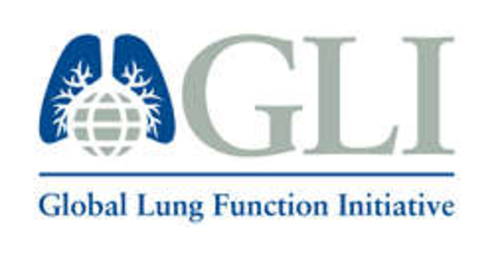Spirometry
The GLI Spirometry Task Force derived continuous prediction equations and their lower limits of normal for
spirometric indices. Over 160,000 data points from 72 centres in 33 countries were shared with the GLI.
Eliminating data that could not be used (mostly missing ethnic group, some outliers) left 97,759 records of
healthy nonsmokers (55.3% females) aged 2.5–95 yrs.
Lung function data were collated and prediction equations derived using the LMS method, which allows
simultaneous modelling of the mean (mu), the coefficient of variation (sigma) and skewness (lambda) of a
distribution family.
Reference equations were derived for healthy individuals aged 3–95 yrs for Caucasians (n=57,395),
African–Americans (n=3,545), and North (n=4,992) and South East Asians (n=8,255). Forced expiratory value in
1 s (FEV1) and forced vital capacity (FVC) between ethnic groups differed proportionally from that in
Caucasians, such that FEV1/FVC remained virtually independent of ethnic group. For individuals not
represented by these four groups, or of mixed ethnic origins, a composite equation taken as the average of
the above equations is provided to facilitate interpretation until a more appropriate solution is developed.
Additional data from the Indian subcontinent and Arabic, Polynesian and Latin American countries, as well
as Africa will further improve these equations in the future.
Publication: ERSJournal
Spirometry - race-neutral equations
In response to new evidence questioning the use of race-specific reference equations for the interpretation
of lung function, the GLI has recently created race-neutral equations, GLI-Global, which do not require
race/ethnicity as an input in spirometry interpretation. These equations were derived from the same data as
the Quanjer 2012 equations, but applied inverse probability weights so that each racial and ethnic group
contribute equally to the predicted values. The use of a single “Global” spirometry equation reflects the
wide range of lung function observed within and between populations. Given the inherent limitations of any
reference equation, the use of GLI Global equations to interpret spirometry requires careful consideration
of an individual’s symptoms and medical history when used to make clinical, employment, and insurance
decisions.
To obtain race-neutral estimates of spirometry, calculated via the GLI-Global equations please either:
- Select "race-neutral" in the Spirometry section on the web page
- Use ethnic=0 for all for individuals when using the Excel calculator or the API
Please note that at this time race-neutral reference values have not been derived for FEF25-75, FEV0.75,
FEV0.75/FVC, and will not return a predicted value nor z-score for these parameters.
Publication: American Journal of Respiratory and
Critical Care Medicine
TLCO
25 September 2020: It was recently brought to our attention that females with low TLco values had
exceptionally low z-scores when calculated using the GLI TLCO calculator. We subsequently looked through the
models and original data and identified an anomaly which was likely due to a discrepancy in the label that
was assigned to sex in one of the datasets (n=282 females; n=259 males). Upon identifying this source of
error, we re-analyzed the data excluding this centre and recalculated the predicted values and tables. The
primary difference is in the predicted values for adult females, and for the calculation of z-scores in
adult females; there will be minimal differences in the percent predicted values (average percent predicted
change 1.02% (SD 2.0%). Although the differences in males were minimal (average percent predicted change
0.6% (SD 0.4%)), the prediction equations for males also changed in the re-analysis.
Although every effort was made to harmonize and clean the data, regrettably this was an error that was
missed by our team. We recognize that this will impact on previously calculated values and will make every
effort to notify the respiratory community, including the manufacturers, to ensure the updated formulas are
implemented.
ERSJournal Correction
The aim of the study was to develop The Global Lung Function Initiative (GLI) all-age reference values for
TL,CO. Data from 19 centres in 14 countries were collected to define TL,CO reference values. Similar to the
GLI spirometry project, reference values were derived using the LMS method and the GAMLSS program in R.
total of 12 660 TL,CO measurements from asymptomatic, lifetime non-smokers were submitted; 85% of the
submitted data were from Caucasians. All data were uncorrected for haemoglobin (Hb) concentration. Following
adjustments for elevation above sea level, gas concentration, and assumptions used for calculating the
anatomic dead space volume, there was a high degree of overlap among the datasets. Reference values for
Caucasians aged 5 to 85 years were derived for TL,CO, carbon monoxide transfer coefficient (KCO) and
alveolar volume (VA).
Publication: ERSJournal
Lung Volumes
The Global Lung Function Initiative (GLI) all-age reference values for static lung volumes were developed by
an ERS Task Force. Data from 17 centres in 12 countries were collected from Caucasian subjects between the
ages of 5 and 80 years to define static lung volume reference values. Similar to the GLI spirometry and
TL,CO project, reference values were derived using the LMS method and the GAMLSS program in R. A total of
7190 static lung volume measurements using body plethysmography and gas dilution techniques from individual,
healthy participants were collated. Measurements of functional residual capacity (FRC) collected using
plethysmography and dilution techniques showed physiologically insignificant differences and were combined.
Sex specific reference equations including height and age were developed for total lung capacity (TLC), FRC,
residual volume (RV), inspiratory capacity (IC), vital capacity (VC) and expiratory reserve volume (ERV) and
RV/TLC datasets. Further details can be found in the publication.
Publication: ERSJournal
Multiple Breath Washout
Multiple breath washout is a lung function test based on tidal breathing that assesses lung volume and ventilation distribution. The Global Lung Function Initiative methodology was used to develop all-age reference equations for the multiple breath washout indices lung clearance index (LCI) and functional residual capacity (FRC). Multiple breath washout data from healthy individuals were collated from sites. Reference equations were derived from 1581 unique observations from participants between the ages of 2 and 81 years. Equipment type, inert tracer gas, and equipment dead space volume did not significantly affect the prediction equations for either LCI or FRC. Reference equations for LCI include age as the only predictor, whereas sex-specific reference equations for FRC included height and age. Further details can be found in the publication.
Publication: ERSJournal
See more at: Lungfunction.org

 LungTracker
LungTracker
